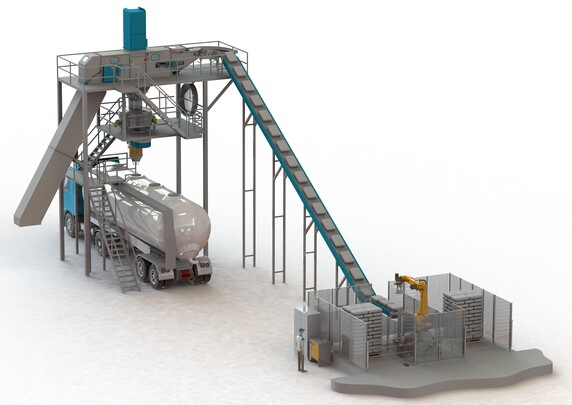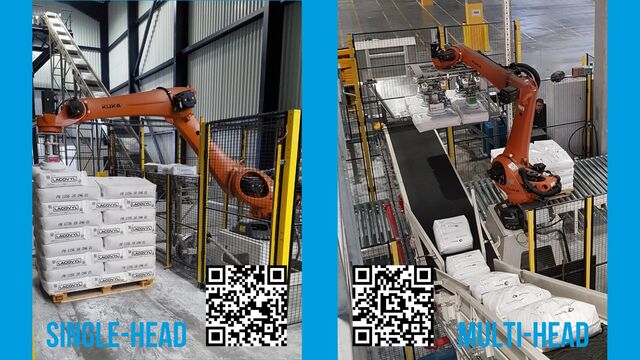Robot for Galahad bag emptying machine
Bulk goods such as powders and granulates are still being packaged in 25 kg bags on a large scale, even when the market often demands otherwise. With the Galahad bag slitting and emptying machine one can easily repackage from bags to Big-Bags, octabins, bulk trucks or bulk storage. TBMA now also offers the Galahad extended with a robot for fully automatic feeding.
Value Added Logistics
Value Added Logistics (VAL) is the creation of higher added value in the logistics chain. In addition to transport, many transport companies also offer for example, the packaging, weighing and labelling of products. This is also the case in the bulk industry: dry bulk goods are often transported in bulk quantities. From plastic to titanium dioxide, from starch to sugar and from cement to carbon black.
For a well-known logistics service provider in Marseille, mainly active in the (petro)chemical industry, TBMA has supplied an installation for fully automatic quick and direct loading of bulk trucks. A robot places 25kg bags with emulsion PVC powder on a conveyor belt, that transports the bags to a Galahad full-automatic bag slitting and emptying machine. This way a single operator can load a 25ton truck in approximately one hour.
Robot technology with image sensor
Two full pallets with bags are placed at the pick-up point of the robot before the operator starts the line. The robot is equipped with an image sensor to determine the correct position of the pallet and the bags. Using these coordinates to control the robot arm, the bags are put on the conveyor belt. This way, less well stacked or shifted pallets can also be processed without any problems. The robot as well as the conveyor belt are shielded for the operator’s safety.
By using special vacuum technology, the bags are lifted one by one and put on the belt. This technology also ensures that the bags are securely sucked in, resulting in only a small loss. The conveyor belt transports the bags into the Galahad, where they are cut open and emptied. After being sifted, the product is loaded into the truck through a loading chute with a dust-tight connection. All empty bags are then compressed and discarded. When the first pallet is empty, the robot automatically moves on to the second pallet. The operator then replaces the empty pallet with a full one.
Single-head or multi-head
Cost savings and regulations in the field of working conditions are increasingly leading to robotization of heavy work. The Galahad can easily be expanded with a robot for a fully automatic supply of the bags. In most cases, this also applies to pre-existing Galahads.
The robot can be equipped with a single-head or multi-head. The single-head takes a single 25 kg bag at a time and has a maximum capacity of 500 bags or 12,5 tons per hour. A multi-head can pick up a complete layer of 5 bags in one go, which allows a capacity up to 1.000 bags or 25 tons / hour. For both versions, the system can be operated by one person, making the ROI very interesting.
More info available at Galahad specifications page or download section.
Lifting standards
There is no legal provision for how much an employee may lift manually, but it is usually assumed that 23 pounds is the maximum. Not only weight plays a role, but also frequency, distance of movement, height from floor and rotation of the body. In the Netherlands, this resulted years ago into, for example, sand and cement to be packed in bags weighing maximum 25 kg. However, this does not apply to products imported from other continents: e.g. coffee and sugar are still packed in 50 or even 70 kg bags.

